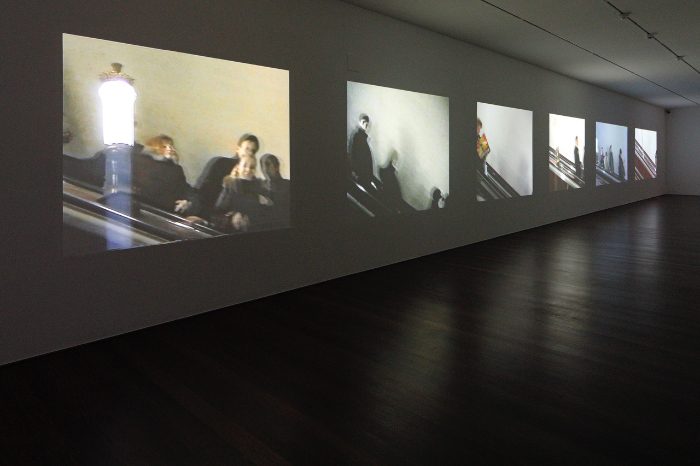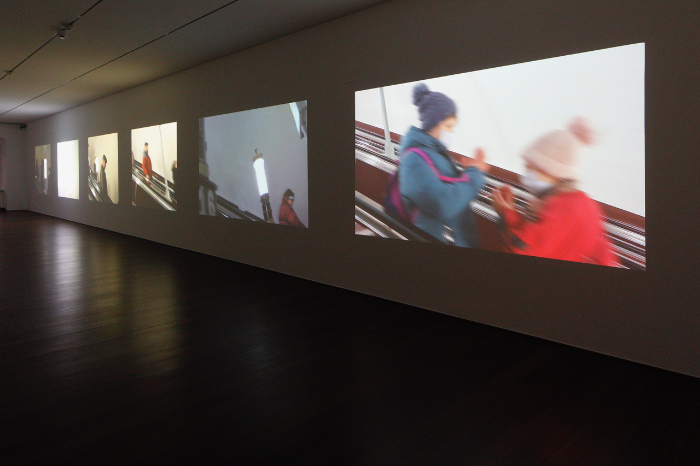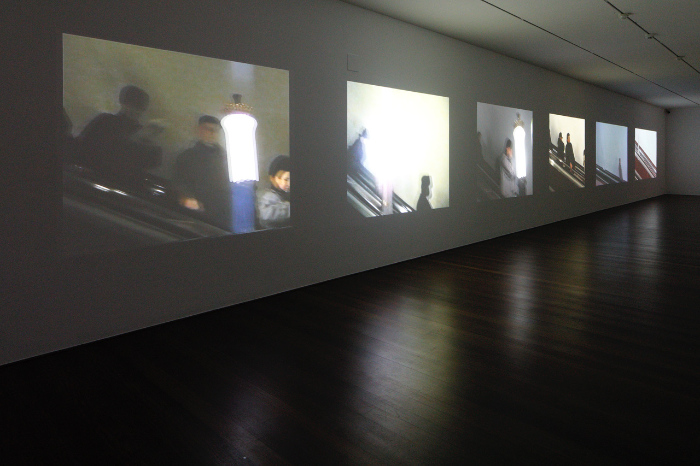Five Year Plan, video, work in progress, to date 6-channel videoinstallation, since 1996



We are dealing here with a five year plan for eternity: two escalators running parallel to one another in opposite directions. One is going down and there are people on it; the other is going up and carries the camera. There is no safe point from which to observe, just as there is no moment of arrival – neither at a platform for the Metro nor into daylight. Everything is governed by the rules of the loop. Anna Jermolaewa pursues the issue of historical progress linked to the term ‘five year plan’ under Socialist regimes in a video installation where linear movement is conveyed in a loop, which is in principle the escalator itself here. The people who traverse the image are a random crowd, something which first became interesting for cinema during the 1920s when films were made showing average people in typical situations – films about everyday life in a town or community that didn’t aim to focus on the extraordinary anymore but on everyday things, the rhythm of communal life. The Man With The Movie Camera(1929) by Dziga Vertov effectively provided a stocktake of revolutionary Soviet society. The installation Five Year Planis based on a camera perspective that could have been inspired by Vertov himself as Anna Jermolaewa films using a discrete camera; she moves between the people with an interest in ‘cinematic truth’. Even if they are not explicitly identified as such, these people are still recognisable as the descendants of Soviet citizens from the 1920s. It is the montage that closes in on the differences in epochs between the emergence of Soviet society and its end, towards which Anna Jermolaewa left, moving from Leningrad to the West.
It turns out that totality can be more easily shown with a short video sequence than with a documentary of epic proportions. It is its privilege (and ironic) that art can translate something that is extensively represented in the history books or by sociologists, by documentary films too, into a single trope. The end of Socialism is a
fact that cannot be stated without producing contradictions. In this sense, the installation Five Year Planis a full realisation of what Deleuze described regarding The Man With The Movie Camera, i.e.: that the most charming farmer’s wife or the most heart-warming child are transformers that recorded movements and caused changes that no longer stood in any relationship to their own dimensions.1 This (euphoric) lack of proportion was of course linked to Vertov’s political utopianism. For Anna Jermolaewa it is part of what is (counter-euphorically and laconically) the dispositif of art. All of her video pieces work on a redefinition of proportions, and if she alludes to Eisenstein as well as to Vertov then this presumably has to do with the great value accorded to every single shot in the Soviet revolution film. An ‘empty’ image would have brought the dialectic to a standstill, would have put ‘the staccato montage’ out of action and with it the subject matter itself. The steps of Odessa in The Battleship Potemkin(down which a pram rattles) is a metonym for this dialectic. In Anna Jermolaewa’s video these steps become an escalator, an image (of) going nowhere.
1 Gilles Deleuze, Das Bewegungs-Bild. Kino 1, Frankfurt/Main 1997, S. 62
Bert Rebhandl: Staccatoed Ideas. Anna Jermolaewa, Adaptations Of The Movie Apparatus
in: Anna Jermolaewa Big Sister / The Five Year Plan, Ausst.Kat., Herausg. v. Gerald Matt f.d. Ursula Blickle Stiftung, Wien, 2002.
***
Es ist ein Fünfjahresplan für die Ewigkeit: Zwei Rolltreppen laufen aneinander vorbei. Die eine führt nach unten, sie befördert Menschen. Die andere führt nach oben, sie befördert die Kamera.
Eine sichere Beobachterposition gibt es nicht, ebensowenig wie ein Ankommen auf dem Bahnsteig der U-Bahn oder im Tageslicht. Alles unterliegt dem Gesetz des Loops. Die Frage des historischen Fortschritts, die im real-existierenden Sozialismus mit dem Begriff Fünfjahresplan verbunden war, erledigt sich bei Anna Jermolaewa in einer Videoinstallation, in der lineare Bewegung in eine Schleife überführt wird, die im Prinzip die Rolltreppe selbst ist. Die Menschen, die das Bild durchqueren, sind eine Zufallsmenge, für die sich das Kino in den Zwanzigerjahren erstmals zu interessieren begann, als jene Querschnittfilme entstanden, die aus dem Leben in einer Stadt oder einer Kommune nicht mehr das Ungewöhnliche, sondern das Alltägliche hervorheben wollten, den Rhythmus eines Gemeinwesens. Der Mann mit dem kinematographischen Apparat von Dziga Vertov aus dem Jahr 1929 zog für die revolutionäre sowjetische Gesellschaft diese Summe. Die Installation Fünfjahresplanbasiert auf einer Einstellung, die von Vertov inspiriert sein könnte, denn auch Anna Jermolaewa filmt mit einer diskreten Kamera, sie bewegt sich mit dem Interesse an einer „Kino-Wahrheit“ zwischen den Menschen: Sie sind, wenn auch nicht audrücklich als solche ausgewiesen, doch erkennbar als Nachfahren der sowjetischen Bürger der Zwanzigerjahre. Es ist die Montage, die den epochalen Unterschied einholt zwischen dem Aufbruch jener Gesellschaft, die Anna Jermolaewa an deren Ende von Leningrad aus nach Westen verließ: Es stellt sich heraus, daß sich mit einer kurzen Videosequenz Totalität leichter darstellen lässt als mit einem epischen Dokumentarfilm. Es ist das Privileg (und die Ironie) der Kunst, in eine Figur zu übersetzen, was die Geschichtsschreibung oder die Soziologie, aber auch der Dokumentarfilm extensiv darstellen. Das Ende des Sozialismus ist eine Tatsache, die nicht aussagbar ist, ohne Widersprüche zu produzieren. In diesem Sinn realisiert erst die Installation Fünfjahresplanvollständig, was Deleuze mit Blick auf Der Mann mit dem kinematographischen Apparat geschrieben hatte: Die „reizendste Bäuerin oder das rührendste Kind“ sind Transformatoren, die „Bewegungen aufnahmen“ und Veränderungen bewirkten, die
„in keinem Verhältnis mehr zu ihren eigenen Dimensionen standen“.1
Diese (euphorische) Unverhältnismäßigkeit war bei Vertov natürlich Teil einer politischen Utopie. Bei Anna Jermolaewa ist sie Teil des (konter-euphorischen, lakonischen) Dispositivs der Kunst. Alle ihre Videoarbeiten arbeiten an einer Neubestimmung der Verhältnismäßigkeiten, und wenn sie sich neben Vertov auch noch auf Eisenstein beruft, so hat dies wohl damit zu tun, welchen großen Stellenwert im sowjetischen Revolutionsfilm jede einzelne Einstellung hatte. Ein „leeres“ Bild hätte die Dialektik zum Stillstand gebracht, hätte die „springende Montage“ lahmgelegt, und damit die Materie. Die Treppe von Odessa in Panzerkreuzer Potemkin (über die ein Kinderwagen hinuntertorkelt) ist die Metonymie dieser Dialektik. Bei Anna Jermolaewa wird diese Treppe zur Rolltreppe, zu einem Bild, das sich leerläuft.
1 Gilles Deleuze, Das Bewegungs-Bild. Kino 1, Frankfurt/Main 1997, S. 62
Aus:Bert Rebhandl: Gedankensprünge. Anna Jermolaewas Umbauten am kinematographischen Apparat,
in: Anna Jermolaewa Big Sister / The Five Year Plan, Ausst.Kat., Herausg. v. Gerald Matt f.d. Ursula Blickle Stiftung, Wien, 2002.